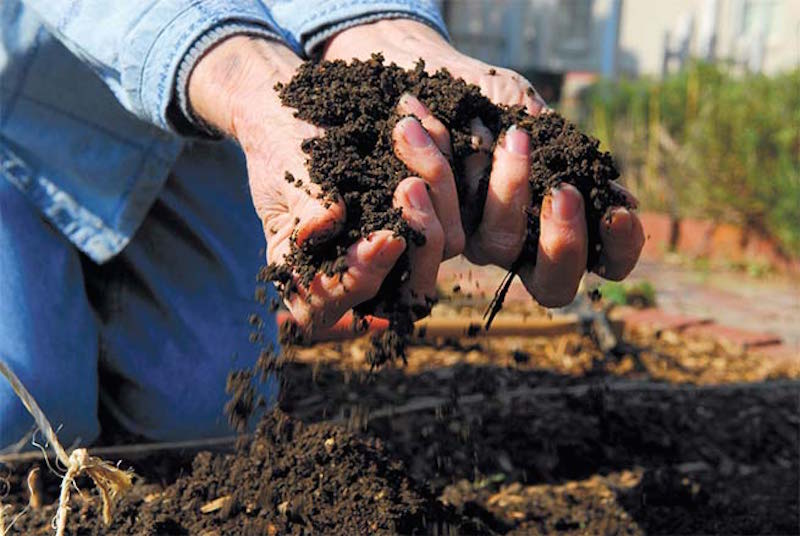Planting Starts with Rich Organic Soil
“Gardening is not a rational act,” the great Canadian writer Margaret Atwood once wrote. “In the spring, at the end of the day, you should smell like dirt.”
When you think about it, coupling with nature to grow one’s own food is a creative connection to life and health. Atwood is right: Gardening can feel like the infatuation of a new love, captivating every sense.
But like in life, the love affair can turn dicey when expectations meet reality. What gardener has not looked in disgust at an unruly, weedy garden? What gardener has not felt betrayal when the love lavished on a garden is eclipsed by pests, pillaged by disease or otherwise ruined by any of Nature’s follies?
Like love, tending a garden is an investment in time, effort and money. It is risky business offering few guarantees. In all affairs of the heart, respect lays the foundation for deeper growth and for a gardener this means respecting nature to work with her, not against.
Experienced gardeners look past the appearance of design and plants and start first by respecting the soil, which is where the spark, the energy, the magic of gardening begins. They know that while its humble appearance might not match the excitement of blooms and foliage, soil is where the action is. It’s where the party starts and where the connection of seed, water, light and air ignite. Simply put, soil is sexy. Working the soil is where the big payoff of a successful garden starts. As a garden designer, I enjoying assisting others with their gardens. When I ask, “What soil do you want to use for your garden?” I get a myriad of answers.
“I compost, so I use that,” is one common response.
“I use a scoop of topsoil,” is another.
And to both of these comments I say, “Great!” I answer. “But that’s not the same as using good soil.”
Initially, a gardener should expect to invest as much in their soil as in the plants they choose. But what a value that is! If you consider that Nature favors the strong, then you understand that a solid foundation of soil builds the health of your plants and therefore protects them from pests and disease. Why not invest in the beginning towards healthy plants rather than spend cash to beat back the pests? While a good soil won’t guarantee pests won’t find your beloved plants, it will provide a good defense against them.
What does it mean when a soil component is termed “organic”?
Good question.
An organic component is one that is found naturally in nature. It is not made synthetically and not made with pesticides, synthetic fertilizers, sewage sludge or genetically modified organisms. Any product that claims to be “organic” must follow strict guidelines. The Organic Materials Review Institute (OMRI) determines which products are allowed for use in certified organic operations under the USDA National Organic Program. Looking for the “OMRI” stamp is a good way to shop with confidence and to know that your garden will be safe for pollinators, the environment, pets and people.
Additionally, using organic components is good sustainable practice, which means that the process to create the ingredient does not harm nature to create it. Sustainability is an attempt to merge ecology and economy into one harmonious system.
Investing the effort in building rich, organic soil for your garden is the best way to keep the love affair with your garden strong. Before the crisp salad or the dark, earthy taste of leafy greens is on your plate, life lives in the soil. It is the soul of a garden where life—and love—begins.
“The Novel Gardener” gardens, writes and creates in Mid-Town Tulsa. She enjoys creating gardens of all kinds with Grogg’s Green Barn, Tulsa’s only organic garden center. Her work has appeared in Tulsa Review and Oklahoma Gardener.
AN ORGANIC GARDENER’S GUIDE TO SEXY SOIL
Organic simply means “not synthetic.” Here are key organic ingredients to look for when you shop for soil:
Mycorrizhea—An organic “effi ciency expert.” A fungus that creates a colony in and around roots, which increases root structure, thereby increasing the intake of important nutrients.
Humic acid—Also an aid to nutrient uptake, acidity is needed by some plants, such as blueberries, to develop to their full potential.
Earthworm castings—Like giving your plants an energy drink. Earthworms digest minerals from the earth and cast them off , which provide plants a natural, mineral-packed meal.
Bat guano—Cast off from bats, this helps a plant produce blooms.
Fish emulsion—Aids in greenery and blooming.
Vermiculite—Helps with water retention.
Diatomaceous earth—An organic pest control (against ants, fl eas, any pest with eco-skeleton)
Peat moss—Save on that water bill, add peat moss. Some organic gardeners prefer to use coir fiber, sand or perlite. These all aid in water retention and keeping soil moist.
Blood meal—Got yellow leaves on your lettuce? Your soil might need some blood meal, which is rich with nitrogen. Careful: Too much nitrogen produces large plants with little fruit. Blood meal also aids in compost for breaking down the compost.
Bone meal—Plants a little on the small side? Your soil might need a boost of bone meal, which is rich in potassium. Cottonseed burr is another source potassium.
Horticulture molasses—Throw a party for the beneficial microbes! Molasses attracts these garden workers, which deter pests. Molasses also freshens the soil to provide a “kick” to stressed plants.





